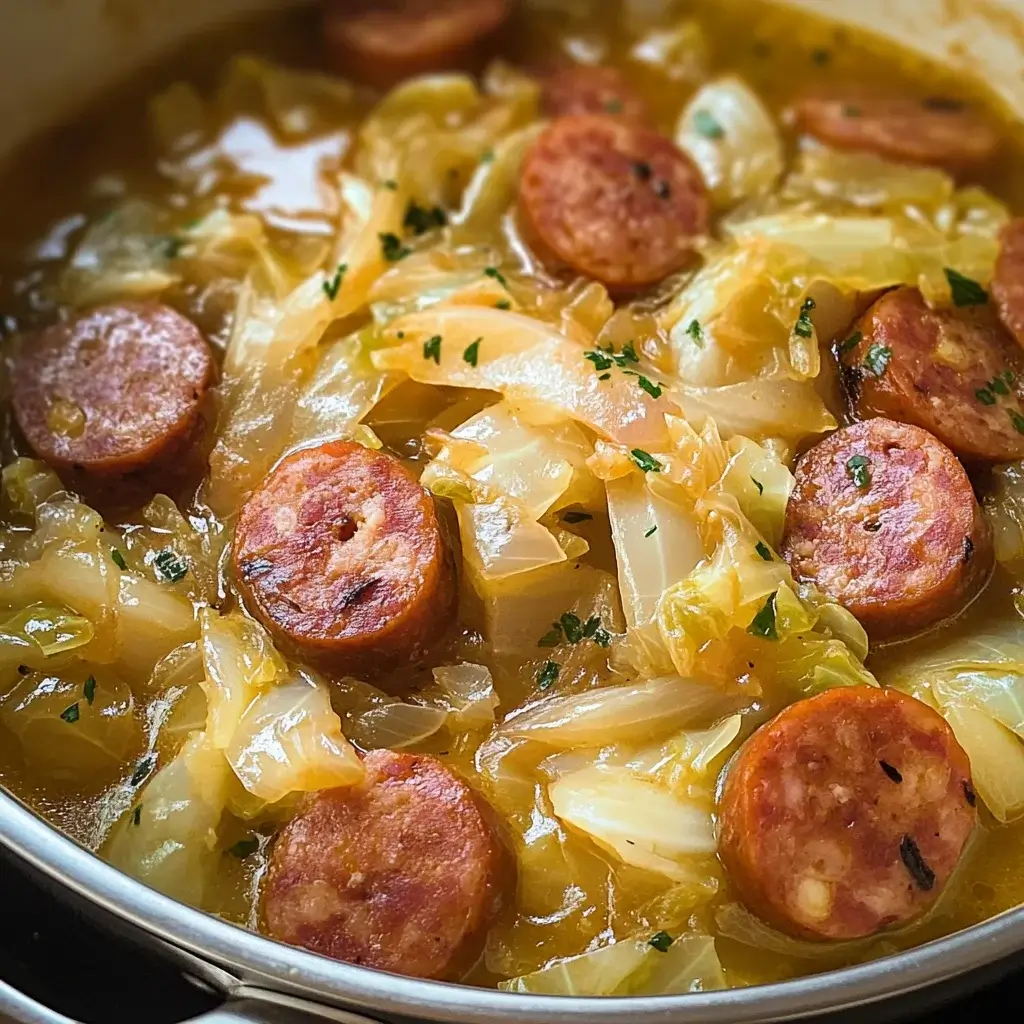There are certain meals that just feel like a warm hug on a chilly evening, and this One-Pot Cabbage and Sausage recipe has firmly cemented its place in that category in our household. I remember the first time I made it – skepticism was high, especially from the younger members of the family who weren’t typically cabbage enthusiasts. The aroma, however, started working its magic long before dinner was served. The savory scent of browning sausage mingling with sautéing onions and garlic, followed by the earthy sweetness of cabbage softening in the pot, filled the kitchen and drew everyone in. By the time I ladled the steaming mixture into bowls, skepticism had turned into eager anticipation. The verdict? An overwhelming success! The sausage provided a smoky, salty counterpoint to the tender, slightly sweet cabbage, all coated in a light, flavorful broth. Even the picky eaters cleaned their plates, asking when we could have it again. The best part for me, aside from the happy eaters? The ridiculously easy cleanup. One pot means fewer dishes, which is always a win on a busy weeknight. This dish has since become a staple, loved for its comforting flavors, simple preparation, and budget-friendly ingredients. It’s proof that sometimes, the most unassuming combinations create the most satisfying meals.
The Ultimate One-Pot Cabbage and Sausage: Ingredients You’ll Need
This recipe relies on simple, readily available ingredients that come together beautifully. The key is quality – good sausage and fresh cabbage make all the difference. While the core components are straightforward, feel free to adjust seasonings or add complementary vegetables based on your preference. Here’s what you’ll need for a hearty family meal:
- Smoked Sausage: 1 pound (about 450g), preferably Kielbasa or Andouille for authentic flavor, sliced into ½-inch thick rounds. (You can also use turkey sausage, chicken sausage, or spicy Italian sausage, adjusting cooking time if needed).
- Olive Oil or Cooking Fat: 1-2 tablespoons (use less if your sausage is particularly fatty; bacon grease also adds amazing flavor).
- Yellow Onion: 1 large, chopped (about 1.5 cups).
- Garlic: 3-4 cloves, minced (adjust to your taste – more garlic is always welcome!).
- Green Cabbage: 1 medium head (about 2-2.5 pounds), core removed and roughly chopped or shredded into bite-sized pieces. Don’t worry if it looks like too much; cabbage cooks down significantly.
- Chicken Broth or Vegetable Broth: 1 cup (240ml). You can also use beef broth for a richer flavor or even water in a pinch, though broth adds more depth.
- Apple Cider Vinegar: 1 tablespoon (optional, but highly recommended for balancing the richness and adding a slight tang).
- Caraway Seeds: 1 teaspoon (optional, but classic pairing with cabbage and sausage, adds a distinct earthy flavor).
- Smoked Paprika: 1 teaspoon (enhances the smoky flavor).
- Dried Thyme: ½ teaspoon (or 1 teaspoon fresh thyme leaves).
- Salt: ½ teaspoon, or to taste (be mindful that sausage and broth can be salty).
- Black Pepper: ½ teaspoon freshly ground, or to taste.
- Optional additions:
- Red Pepper Flakes: ¼ – ½ teaspoon for a touch of heat.
- Diced Potatoes: 1-2 medium potatoes, peeled and diced (add with the cabbage, may need slightly more liquid and longer cooking time).
- Sliced Carrots: 1-2 carrots, sliced (add with the onions or cabbage).
- Bell Pepper: 1 sliced bell pepper (any color), add during the last 10-15 minutes of simmering.
- Fresh Parsley: Chopped, for garnish (optional).
Ingredient Notes & Deep Dive:
- The Sausage: The star player alongside the cabbage. Kielbasa (Polish sausage) is a popular choice due to its smoky, garlicky flavor and firm texture that holds up well to cooking. Andouille adds a Cajun kick with more spice. Italian sausage (sweet or hot) brings an herby flavor profile. Using pre-cooked smoked sausage simplifies the process. If using raw sausage, ensure it’s cooked through before adding the cabbage. Consider the fat content; leaner options like chicken or turkey sausage work well but might require adding a bit more oil initially. Slicing the sausage allows for maximum surface area browning, which equals more flavor.
- The Cabbage: Green cabbage is the standard choice – it’s affordable, sturdy, and becomes tender and sweet when cooked. Savoy cabbage, with its crinkled leaves, offers a slightly milder flavor and more delicate texture. Napa cabbage cooks much faster and is very tender, so add it later in the cooking process if using. The key is to chop it into manageable, bite-sized pieces. Remember, it shrinks dramatically, so don’t be intimidated by the initial volume. Cabbage is packed with Vitamin K, Vitamin C, and fiber, making this dish surprisingly nutritious.
- The Aromatics: Onion and garlic form the essential flavor base. Yellow onions provide a balanced sweetness when sautéed. Garlic adds its pungent depth. Don’t skimp here; these build the foundation upon which the other flavors rest.
- The Liquid: Broth (chicken, vegetable, or beef) infuses the dish with savory notes far better than water alone. It helps steam the cabbage and creates a light sauce. Choose low-sodium broth if you’re sensitive to salt or want more control over the final seasoning.
- The Seasonings: Caraway seeds are a classic Eastern European pairing with cabbage, offering a unique, slightly anise-like flavor. Smoked paprika echoes the smokiness of the sausage. Thyme adds an earthy, floral note. Apple cider vinegar cuts through the richness of the sausage and brightens the overall flavor profile – a small amount makes a big difference. Adjust salt carefully at the end, considering the saltiness of your chosen sausage and broth.
Step-by-Step Instructions for Perfect One-Pot Cabbage and Sausage
This recipe is designed for simplicity and minimal cleanup, all happening in one large pot or Dutch oven. Follow these steps for a delicious result every time:
- Brown the Sausage: Place a large, heavy-bottomed pot or Dutch oven over medium-high heat. Add the olive oil (or other fat). Once shimmering, add the sliced sausage in a single layer (you may need to do this in batches to avoid overcrowding the pot). Cook for 3-5 minutes per side, until nicely browned and slightly crispy. Browning develops deep flavor (thanks to the Maillard reaction) and renders some fat. Once browned, use a slotted spoon to remove the sausage from the pot and set it aside on a plate. Leave the rendered fat in the pot (if there’s more than 2 tablespoons, you can drain off the excess).
- Sauté the Aromatics: Reduce the heat to medium. Add the chopped yellow onion to the pot with the remaining fat. Sauté for 5-7 minutes, stirring occasionally, until the onion softens and becomes translucent, starting to turn golden at the edges. Add the minced garlic, caraway seeds (if using), smoked paprika, and dried thyme. Cook for another 1-2 minutes, stirring constantly, until the garlic is fragrant. Be careful not to burn the garlic. This step toasts the spices, releasing their aromatic oils.
- Wilt the Cabbage: Add the chopped cabbage to the pot. It might seem like a lot, possibly filling the pot, but don’t worry. Stir it gently to coat it with the fat and aromatics as best as possible. Cook for about 5-7 minutes, stirring occasionally, allowing the cabbage to wilt down significantly. It will release some moisture and become easier to manage.
- Add Liquids and Seasonings: Pour in the chicken (or vegetable/beef) broth and the optional apple cider vinegar. Add the salt and black pepper (and red pepper flakes, if using). Stir everything together well, scraping up any browned bits (fond) from the bottom of the pot – these are packed with flavor!
- Simmer to Perfection: Return the browned sausage to the pot. Stir everything gently to combine. Bring the mixture to a gentle simmer. Once simmering, reduce the heat to low, cover the pot tightly with a lid, and let it cook for 20-30 minutes. The cooking time depends on how tender you like your cabbage.
- For slightly crisp-tender cabbage: Simmer for 20 minutes.
- For very tender, melt-in-your-mouth cabbage: Simmer for 30 minutes or slightly longer.
- If adding potatoes: Ensure they are tender before serving; this might require the longer end of the cooking time or even a bit more.
- Final Touches & Serving: After simmering, remove the lid and give everything a good stir. Taste and adjust seasonings if necessary – more salt, pepper, or even a splash more vinegar? If there’s too much liquid for your liking, you can simmer uncovered for a few extra minutes to let some evaporate. Serve hot, garnished with fresh chopped parsley for a touch of color and freshness.
Why these steps work:
- Browning Sausage First: Creates a flavorful foundation and renders fat for sautéing vegetables. Removing it prevents overcooking while the cabbage simmers.
- Sautéing Aromatics: Softens onions, releases garlic fragrance, and blooms spices for maximum flavor impact.
- Wilting Cabbage: Makes it manageable and starts the cooking process before adding liquid.
- Deglazing: Scraping the bottom of the pot incorporates flavorful browned bits into the sauce.
- Simmering Covered: Traps steam, ensuring the cabbage cooks evenly and becomes tender while allowing flavors to meld.
Nutritional Snapshot: One-Pot Cabbage and Sausage
Understanding the nutritional profile can be helpful. Please note that these values are estimates and can vary significantly based on the specific ingredients used (especially the type of sausage), portion sizes, and any additions.
- Servings: This recipe typically yields 4-6 servings.
- Calories per Serving (Estimated): Approximately 350-500 calories per serving.
Breakdown Considerations:
- Sausage: This is the biggest variable. Traditional pork Kielbasa or Andouille will be higher in calories and fat (including saturated fat) than leaner options like chicken or turkey sausage.
- Cabbage: Low in calories, high in fiber and nutrients.
- Fat: Comes primarily from the sausage and any added cooking oil.
- Carbohydrates: Mainly from the cabbage and onions. Relatively low unless potatoes or other starchy vegetables are added. Cabbage itself is quite low-carb, making the base recipe suitable for lower-carb diets (check sausage carbs).
- Protein: Primarily from the sausage.
- Sodium: Can be high depending on the sausage and broth used. Opting for low-sodium broth and sausage can help manage intake.
For a more precise nutritional count, using a recipe analysis tool and inputting your exact ingredients and quantities is recommended. However, generally speaking, this dish offers a good balance of protein, vegetables, and flavor, making it a satisfying and relatively wholesome meal, especially when using leaner sausage and controlling added fats.
Quick & Easy: Preparation and Cooking Time
One of the major appeals of this One-Pot Cabbage and Sausage recipe is its efficiency in the kitchen. Here’s a breakdown of the time involved:
- Preparation Time: 15 minutes
- This includes washing and chopping the cabbage, chopping the onion, mincing the garlic, and slicing the sausage. Having everything prepped (“mise en place”) before you start cooking makes the process smoother.
- Cooking Time: 40-50 minutes
- Browning Sausage: ~10 minutes
- Sautéing Aromatics: ~8-10 minutes
- Wilting Cabbage: ~5-7 minutes
- Simmering: 20-30 minutes (depending on desired cabbage tenderness)
- Total Time: Approximately 55 minutes to 1 hour 5 minutes
This timeline makes it a feasible option for a weeknight dinner, especially considering the minimal cleanup involved afterward. The hands-on time is mostly at the beginning (prep and sautéing), while the simmering phase requires little attention beyond an occasional stir if desired.
Serving Suggestions: Elevate Your Cabbage and Sausage Meal
While this One-Pot Cabbage and Sausage is hearty and flavorful enough to stand alone, serving it with the right accompaniments can turn it into an even more memorable meal. Here are some ideas:
- Bread:
- Crusty Bread: Essential for soaking up the delicious broth at the bottom of the bowl. A rustic sourdough, French baguette, or a simple crusty roll works wonders.
- Cornbread: A slightly sweet cornbread offers a lovely contrast to the savory dish, particularly popular in Southern-style variations.
- Starchy Sides:
- Mashed Potatoes: Creamy mashed potatoes provide a comforting base, melding beautifully with the cabbage and sausage.
- Egg Noodles: Wide egg noodles, tossed simply with butter and parsley, are a classic pairing, especially in Eastern European contexts.
- Rice: Plain steamed white or brown rice can absorb the flavors well.
- Boiled or Roasted Potatoes: Serve alongside if you haven’t added potatoes directly into the pot.
- Toppings & Garnishes:
- Sour Cream or Greek Yogurt: A dollop adds a cool, creamy tang that balances the richness of the sausage.
- Mustard: A spoonful of spicy brown mustard, Dijon mustard, or even whole grain mustard cuts through the fat and complements the sausage perfectly.
- Hot Sauce: For those who like an extra kick.
- Fresh Herbs: Chopped fresh parsley adds freshness and color. Dill is another great option, especially with caraway.
- Simple Salad:
- A light green salad with a simple vinaigrette can offer a fresh counterpoint to the hearty main dish.
Presentation: Serve generously in shallow bowls to contain the broth. Ensure each serving gets a good ratio of cabbage and sausage. Garnish just before serving for the best visual appeal and fresh flavor.
Pro Tips for the Best One-Pot Cabbage and Sausage Ever
Take your dish from good to great with these simple tips:
- Don’t Crowd the Pan When Browning Sausage: For truly browned, flavorful sausage (not steamed!), cook it in batches if necessary. Give the slices space in the hot pan. This allows the Maillard reaction to occur properly, creating that desirable deep brown color and complex flavor.
- Control Cabbage Texture: The simmering time dictates the final texture. If you prefer cabbage with a bit more bite (crisp-tender), stick to the shorter simmering time (around 20 minutes). For super soft, melt-in-your-mouth cabbage, let it simmer longer (30+ minutes). You can even add half the cabbage initially and the other half midway through simmering for varied textures.
- Layer Flavors Deliberately: Don’t just dump everything in. Browning the sausage first, then sautéing the onions until softened and sweet, followed by blooming the garlic and spices – each step builds a layer of flavor that contributes to the final delicious result. Don’t forget to scrape up the fond (browned bits) when adding the liquid!
- Balance with Acidity: The optional splash of apple cider vinegar (or even white vinegar or a squeeze of lemon juice at the end) might seem minor, but it works wonders. It cuts through the richness of the sausage fat, brightens the overall flavor profile, and prevents the dish from tasting too heavy or one-note.
- Taste and Adjust Seasoning at the End: Sausage and broth vary wildly in salt content. Season lightly initially (especially with salt), then taste the dish after it has simmered and all the flavors have melded. Adjust salt, pepper, acidity (vinegar), or even add a pinch of sugar if needed to balance everything perfectly before serving.
Frequently Asked Questions (FAQ) about One-Pot Cabbage and Sausage
Here are answers to some common questions about making this delicious dish:
- Q: Can I use a different type of sausage?
- A: Absolutely! This recipe is very versatile. While smoked Kielbasa or Andouille are classic choices, feel free to experiment. Try spicy Italian sausage (remove casings and crumble if desired, or slice links), bratwurst (pre-cooked or brown raw ones thoroughly), chicken sausage, or turkey sausage for a leaner option. Just be mindful that different sausages bring different flavor profiles (smoky, spicy, herby) and fat content, which might slightly alter the final dish. Adjust cooking times if using raw sausage.
- Q: How can I make this recipe vegetarian or vegan?
- A: Easily! Substitute the sausage with a plant-based alternative. There are many excellent vegan sausages available now that mimic the texture and flavor of traditional ones. Alternatively, use hearty vegetables like cubed potatoes, large chunks of mushrooms (portobello or cremini work well), or even white beans or chickpeas (added towards the end of simmering) instead of sausage. Ensure you use vegetable broth instead of chicken broth. The core flavor profile of cabbage, onions, garlic, and seasonings remains delicious.
- Q: Is this One-Pot Cabbage and Sausage recipe low-carb or keto-friendly?
- A: Generally, yes, the base recipe can be very low-carb and keto-friendly. Cabbage itself is low in net carbs. The main carb sources are the onion and potentially the sausage (check labels for added sugars or fillers). Stick to low-carb sausage varieties, use onions in moderation, and avoid adding higher-carb vegetables like potatoes or carrots. Served on its own or with cauliflower rice/mash, it fits well into a low-carb or ketogenic diet. Always check the nutritional information of your specific sausage brand.
- Q: Can I freeze leftovers? How long does it last?
- A: Yes, this dish freezes reasonably well, although the texture of the cabbage might become slightly softer upon reheating. Let the dish cool completely before transferring it to airtight, freezer-safe containers. It can be frozen for up to 2-3 months. To reheat, thaw it overnight in the refrigerator and then gently reheat on the stovetop over medium-low heat or in the microwave until heated through. You might need to add a splash of broth or water if it seems dry. Leftovers stored in an airtight container in the refrigerator will last for 3-4 days.
- Q: My cabbage always gets too mushy. How can I prevent that?
- A: Mushy cabbage usually results from overcooking. Here are a few ways to prevent it:
- Reduce Simmering Time: Start checking the cabbage around the 15-20 minute mark of simmering. Stop cooking when it reaches your desired tenderness.
- Cut Cabbage Larger: Chopping the cabbage into slightly larger pieces will help it hold its shape better during cooking.
- Add Cabbage Later: Sauté the onions and sausage, add the broth, bring to a simmer, and then add the cabbage. This reduces its total cooking time.
- Use Sturdier Cabbage: Green cabbage or Savoy cabbage hold up better than Napa cabbage for longer cooking methods.
- A: Mushy cabbage usually results from overcooking. Here are a few ways to prevent it:

One-Pot Cabbage and Sausage recipe
Ingredients
- Smoked Sausage: 1 pound (about 450g), preferably Kielbasa or Andouille for authentic flavor, sliced into ½-inch thick rounds. (You can also use turkey sausage, chicken sausage, or spicy Italian sausage, adjusting cooking time if needed).
- Olive Oil or Cooking Fat: 1-2 tablespoons (use less if your sausage is particularly fatty; bacon grease also adds amazing flavor).
- Yellow Onion: 1 large, chopped (about 1.5 cups).
- Garlic: 3-4 cloves, minced (adjust to your taste – more garlic is always welcome!).
- Green Cabbage: 1 medium head (about 2-2.5 pounds), core removed and roughly chopped or shredded into bite-sized pieces. Don’t worry if it looks like too much; cabbage cooks down significantly.
- Chicken Broth or Vegetable Broth: 1 cup (240ml). You can also use beef broth for a richer flavor or even water in a pinch, though broth adds more depth.
- Apple Cider Vinegar: 1 tablespoon (optional, but highly recommended for balancing the richness and adding a slight tang).
- Caraway Seeds: 1 teaspoon (optional, but classic pairing with cabbage and sausage, adds a distinct earthy flavor).
- Smoked Paprika: 1 teaspoon (enhances the smoky flavor).
- Dried Thyme: ½ teaspoon (or 1 teaspoon fresh thyme leaves).
- Salt: ½ teaspoon, or to taste (be mindful that sausage and broth can be salty).
- Black Pepper: ½ teaspoon freshly ground, or to taste.
- Optional additions:
- Red Pepper Flakes: ¼ – ½ teaspoon for a touch of heat.
- Diced Potatoes: 1-2 medium potatoes, peeled and diced (add with the cabbage, may need slightly more liquid and longer cooking time).
- Sliced Carrots: 1-2 carrots, sliced (add with the onions or cabbage).
- Bell Pepper: 1 sliced bell pepper (any color), add during the last 10-15 minutes of simmering.
- Fresh Parsley: Chopped, for garnish (optional).
Ingredient Notes & Deep Dive:
- The Sausage: The star player alongside the cabbage. Kielbasa (Polish sausage) is a popular choice due to its smoky, garlicky flavor and firm texture that holds up well to cooking. Andouille adds a Cajun kick with more spice. Italian sausage (sweet or hot) brings an herby flavor profile. Using pre-cooked smoked sausage simplifies the process. If using raw sausage, ensure it’s cooked through before adding the cabbage. Consider the fat content; leaner options like chicken or turkey sausage work well but might require adding a bit more oil initially. Slicing the sausage allows for maximum surface area browning, which equals more flavor.
- The Cabbage: Green cabbage is the standard choice – it’s affordable, sturdy, and becomes tender and sweet when cooked. Savoy cabbage, with its crinkled leaves, offers a slightly milder flavor and more delicate texture. Napa cabbage cooks much faster and is very tender, so add it later in the cooking process if using. The key is to chop it into manageable, bite-sized pieces. Remember, it shrinks dramatically, so don’t be intimidated by the initial volume. Cabbage is packed with Vitamin K, Vitamin C, and fiber, making this dish surprisingly nutritious.
- The Aromatics: Onion and garlic form the essential flavor base. Yellow onions provide a balanced sweetness when sautéed. Garlic adds its pungent depth. Don’t skimp here; these build the foundation upon which the other flavors rest.
- The Liquid: Broth (chicken, vegetable, or beef) infuses the dish with savory notes far better than water alone. It helps steam the cabbage and creates a light sauce. Choose low-sodium broth if you’re sensitive to salt or want more control over the final seasoning.
- The Seasonings: Caraway seeds are a classic Eastern European pairing with cabbage, offering a unique, slightly anise-like flavor. Smoked paprika echoes the smokiness of the sausage. Thyme adds an earthy, floral note. Apple cider vinegar cuts through the richness of the sausage and brightens the overall flavor profile – a small amount makes a big difference. Adjust salt carefully at the end, considering the saltiness of your chosen sausage and broth.
Instructions
- Brown the Sausage: Place a large, heavy-bottomed pot or Dutch oven over medium-high heat. Add the olive oil (or other fat). Once shimmering, add the sliced sausage in a single layer (you may need to do this in batches to avoid overcrowding the pot). Cook for 3-5 minutes per side, until nicely browned and slightly crispy. Browning develops deep flavor (thanks to the Maillard reaction) and renders some fat. Once browned, use a slotted spoon to remove the sausage from the pot and set it aside on a plate. Leave the rendered fat in the pot (if there’s more than 2 tablespoons, you can drain off the excess).
- Sauté the Aromatics: Reduce the heat to medium. Add the chopped yellow onion to the pot with the remaining fat. Sauté for 5-7 minutes, stirring occasionally, until the onion softens and becomes translucent, starting to turn golden at the edges. Add the minced garlic, caraway seeds (if using), smoked paprika, and dried thyme. Cook for another 1-2 minutes, stirring constantly, until the garlic is fragrant. Be careful not to burn the garlic. This step toasts the spices, releasing their aromatic oils.
- Wilt the Cabbage: Add the chopped cabbage to the pot. It might seem like a lot, possibly filling the pot, but don’t worry. Stir it gently to coat it with the fat and aromatics as best as possible. Cook for about 5-7 minutes, stirring occasionally, allowing the cabbage to wilt down significantly. It will release some moisture and become easier to manage.
- Add Liquids and Seasonings: Pour in the chicken (or vegetable/beef) broth and the optional apple cider vinegar. Add the salt and black pepper (and red pepper flakes, if using). Stir everything together well, scraping up any browned bits (fond) from the bottom of the pot – these are packed with flavor!
- Simmer to Perfection: Return the browned sausage to the pot. Stir everything gently to combine. Bring the mixture to a gentle simmer. Once simmering, reduce the heat to low, cover the pot tightly with a lid, and let it cook for 20-30 minutes. The cooking time depends on how tender you like your cabbage.
- For slightly crisp-tender cabbage: Simmer for 20 minutes.
- For very tender, melt-in-your-mouth cabbage: Simmer for 30 minutes or slightly longer.
- If adding potatoes: Ensure they are tender before serving; this might require the longer end of the cooking time or even a bit more.
- Final Touches & Serving: After simmering, remove the lid and give everything a good stir. Taste and adjust seasonings if necessary – more salt, pepper, or even a splash more vinegar? If there’s too much liquid for your liking, you can simmer uncovered for a few extra minutes to let some evaporate. Serve hot, garnished with fresh chopped parsley for a touch of color and freshness.
Nutrition
- Serving Size: one normal portion
- Calories: 350-500





